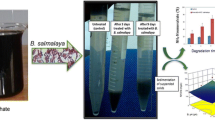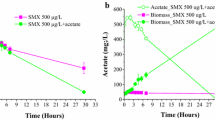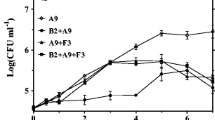Abstract
The Aminobacter sp. strain MSH1 has potential for pesticide bioremediation because it degrades the herbicide metabolite 2,6-dichlorobenzamide (BAM). Production of the BAM-degrading bacterium using aerobic bioreactor fermentation was investigated. A mineral salt medium limited for carbon and with an element composition similar to the strain was generated. The optimal pH and temperature for strain growth were determined using shaker flasks and verified in bioreactors. Glucose, fructose, and glycerol were suitable carbon sources for MSH1 (μ = 0.1 h−1); slower growth was observed on succinate and acetic acid (μ = 0.01 h−1). Standard conditions for growth of the MSH1 strain were defined at pH 7 and 25 °C, with glucose as the carbon source. In bioreactors (1 and 5 L), the specific growth rate of MSH1 increased from μ = 0.1 h−1 on traditional mineral salt medium to μ = 0.18 h−1 on the optimized mineral salt medium. The biomass yield under standard conditions was 0.47 g dry weight biomass/g glucose consumed. An investigation of the catabolic capacity of MSH1 cells harvested in exponential and stationary growth phases showed a degradation activity per cell of about 3 × 10−9 μg BAM h−1. Thus, fast, efficient, large-scale production of herbicide-degrading Aminobacter was possible, bringing the use of this bacterium in bioaugmentation field remediation closer to reality.



Similar content being viewed by others
References
Albers CN, Jacobsen OS, Aamand J (2013) Using 2,6-dichlorobenzamide (BAM) degrading Aminobacter sp. MSH1 in flow through biofilters—initial adhesion and BAM degradation potential. Appl Microbiol Biotechnol. doi:10.1007/s00253-013-4942-6
Beynon KI, Wright AN (1972) The fates of the herbicides chlorthiamid and dichlobenil in relation to residues in crops, soils and animals. Residue Rev 43:23–53
Björklund E, Styrishave B, Anskjær GG, Hansen M, Halling-Sørensen B (2011) Dichlobenil and 2,6-dichlorobenzamide (BAM) in the environment: what are the risks to humans and biota ? Sci Total Environ 409:3732–3739
Bourque D, Groleau D (1990) Influence of oxygenation and carbon dioxide on the growth of Rhizobium meliloti in a fermenter. World J Microbiol Biotechnol 6:273–280
Boxall ABA, Sinclair CJ, Fenner K, Kolpin D, Maud SJ (2004) When synthetic chemicals degrade in the environment. Environ Sci Technol 38:368A–375A
Clausen L, Arildskov NP, Larsen F, Aamand J, Albrechtsen HJ (2007) Degradation of the herbicide dichlobenil and its metabolite BAM in soil and subsurface. J Contam Hydrol 89(3–4):157–173
El Fantroussi S, Agathos SN (2005) Is bioremediation a feasible strategy for pollutant removal and site remediation? Curr Opin Microbiol 8:268–275
Hobbie JE, Daley RJ, Jasper S (1977) Use of nuclepore filters for counting bacteria by fluorescence microscopy. Appl Environ Microbiol 33(5):1225–1228
Holtze MS, Sørensen SR, Sørensen J, Aamand J (2008) Microbial degradation of the benzonitrile herbicide dichlobenil, bromoxynil and ioxynil in soil and surface environment—insights into degradation pathways, persistent metabolites and involved degrader organisms. Environ Pollut 154:155–168
Kolpin DW, Thurman EM, Linhart SM (2000) Finding minimal herbicide concentrations in ground water? Try looking for their degradates. Sci Total Environ 248:115–122
Newcombe DA, Crowley DE (1999) Biodegradation of atrazine-contaminated soil by repeated applications of atrazine-degrading bacteria. Appl Microbiol Biotechnol 51:877–882
Paisio CE, Talano MA, González PS, Busto VD, Talou JR, Agostini E (2012) Isolation and characterization of a Rhodococcus strain with phenol-degrading ability and its potential use for tannery effluent biotreatment. Environ Sci Pollut 19:3430–3439
Schneebeli R, Egli T (2013) A defined, glucose-limited mineral medium for the cultivation of Listeria. Appl Environ Microbiol 79:2503–2511
Sheehan D (1997) Bioremediation protocols. University College York, Ireland. Humana Press, Totowa
Shi Z, Tian L, Zhang Y (2010) Molecular biology approaches for understanding microbial polycyclic aromatic hydrocarbons (PAHs) degradation. Acta Ecol Sin 30:292–295
Simonsen A, Badawi N, Anskjær GG, Albers CN, Sørensen SR, Sørensen J, Aamand J (2011) Intermediate accumulation of metabolites results in a bottleneck for mineralisation of the herbicide metabolite 2,6-dichlorobenzamide (BAM) by Aminobacter spp. Appl Microbiol Biotechnol 94:237–245
Simonsen A, Badawi N, Anskjær G, Albers CN, Sørensen SR, Sørensen J, Aamand J (2012) Intermediate accumulation of metabolites results in a bottleneck for mineralisation of the herbicide metabolite 2,6-dichlorobenzamide (BAM) by Aminobacter ssp. Appl Microbiol Biotechnol 94:237–245
Sjøholm OR, Nybroe O, Aamand J, Sørensen J (2010) 2,6-Dichlorobenzamide (BAM) herbicide mineralisation by Aminobacter sp. MSH1 during starvation depends on a subpopulation of intact cells maintaining vital membrane functions. Environ Pollut 158:3618–3625
Strong L, McTavish H, Sadowsky MJ, Lawrence PW (2000) Field-scale remediation of atrazine-contaminated soil using recombinant Escherichia coli expressing atrazine chlorohydrolase. Environ Microbiol 2:91–98
Sørensen SR, Holtze MS, Simonsen A, Aamand J (2007) Degradation and mineralization of nanomolar concentrations of the herbicide dichlobenil and its persistent metabolite 2,6-dichlorobenzamide by Aminobacter spp. isolated from dichlobenil-treated soils. Appl Environ Microbiol 73(2):399–406
Thompson IP, van der Gast CJ, Ciric L, Singer AC (2005) Bioaugmentation for bioremediation: the challenge of strain selection. Environ Microbiol 7(7):909–915
Thorling L, Hansen B, Langtofte C, Brüsch W, Møller RR, Mielby S, Højberg AL (2010) Groundwater monitoring 2010 (Grundvandsovervågning 2010). In Danish with English summary (www.grundvandsovervaagning.dk)
Vainberg S, Condee CW, Steffan RJ (2009) Large-scale production of bacterial consortia for remediation of chlorinated solvent-contaminated groundwater. J Ind Microbiol Biotechnol 36:1189–1197
Zhuang WQ, Yi S, Feng X, Zinder S, Tang YJ, Alvarez-Cohen L (2011) Selective utilization of exogenous amino acids by Dehalococcoides ethenogenes strain 195 and its effect on growth and dechlorination activity. Appl Environ Microbiol 77:7797–7803
Acknowledgments
Support was from the MIRESOWA project “Microbial Remediation of Contaminated Soil and Water Resources” funded by the Danish Council for Strategic Research (grant 2104-08-0012). This study was also financially supported by the EU BIOTREAT project “Biotreatment of Drinking Water Resources Polluted by Pesticides, Pharmaceuticals and other Micropollutants” (contract number 266039, call FP7-KBBE-2010.3.5.01). Jørn Kystol (GEUS) is thanked for performing elementary analysis of Aminobacter sp. strain MSH1. Finally, the authors acknowledge the Technical University of Denmark Fermentation Platform at the Department of Systems Biology for providing the bioreactor equipment.
Author information
Authors and Affiliations
Corresponding author
Rights and permissions
About this article
Cite this article
Schultz-Jensen, N., Knudsen, B.E., Frkova, Z. et al. Large-scale bioreactor production of the herbicide-degrading Aminobacter sp. strain MSH1. Appl Microbiol Biotechnol 98, 2335–2344 (2014). https://doi.org/10.1007/s00253-013-5202-5
Received:
Revised:
Accepted:
Published:
Issue Date:
DOI: https://doi.org/10.1007/s00253-013-5202-5




